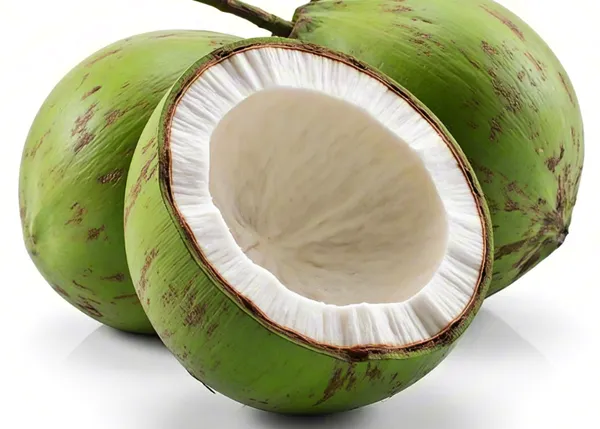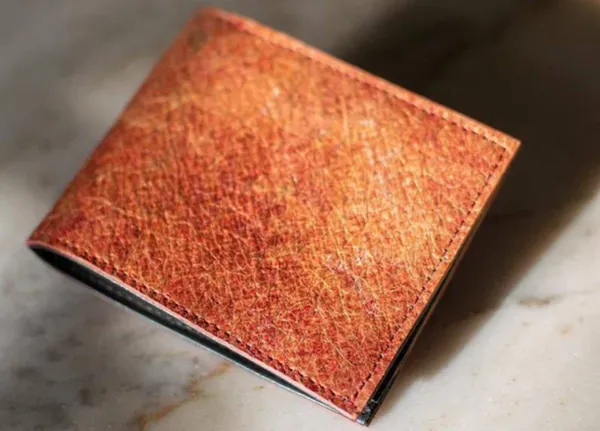Coconut leather is an environmentally friendly, sustainable, plant-based material suitable for lightweight fashion products, especially for brands and consumers who are concerned about ecological and ethical consumption. As global consumers’ demand for sustainable and eco-friendly products grows, the market size of coconut leather is expected to continue to expand.
This article will explore the characteristics of coconut leather and its production process, allowing us to learn about this very promising innovative material in the field of plant-based leather together. If you are running your own bag business, choosing coconut leather material for your bags is also a very good direction.
What is coconut?
The coconut is the edible fruit of the Cocos nucifera, a member of the Arecaceae family. It is a large, brown, hairy and hard fruit. Although it is usually called a nut, in botany it is classified as a stone fruit – a fleshy fruit with a hard stone covering a seed. Coconut trees are native to Southeast Asia, but are now widely planted in tropical regions around the world.
For thousands of years, multi-purpose coconuts have been an important resource, providing food, beverages, oil and materials for countless people.
Coconuts sustain the economies of tropical regions such as the Philippines and Indonesia and are renowned for their eco-friendly and zero-waste potential. In many tropical cultures, coconuts symbolize fertility, prosperity and are used in religious ceremonies. The coconut tree is known as the “tree of life”.
Coconuts have a durable fiber that is used for ropes, MATS and brushes. The inner part of the endocarp is the edible part of the coconut, which is composed of two main components: the white, fleshy coconut flesh (or endosperm) and the clear, refreshing coconut water.

Structure of coconut
- Husk: A fibrous outer layer used for ropes/MATS.
- Shell: The hard middle layer turns into charcoal/artwork.
- Flesh (Meat): The white, edible part, fresh, dried (coconut meat), or used as milk/oil.
- Water: A clear liquid rich in electrolytes from fresh coconuts.
What is coconut leather?
Coconut leather is an innovative, plant-based eco-friendly material made from coconut peel fibers, a by-product of the coconut industry, offering a sustainable and cruelty-free option for the fashion, accessory and design industries. This new type of leather imitates the appearance and feel of traditional leather, while being 100% plant-based, free of plastic and harmful chemicals, biodegradable and compostable.
Comparison to Other Leathers
| Type | Source | Eco-Friendliness | Durability | Cost |
| Coconut Leather | Coconut husk | High | ⭐⭐⭐ (Moderate) | $$$ |
| Animal Leather | Cowhide | Low | ⭐⭐⭐⭐⭐ (High) | $$$$ |
| PU/PVC “Vegan Leather” | Plastic | Low | ⭐⭐⭐⭐ (High) | $$ |
The main characteristics of coconut leather:
Coconut leather possesses several ideal characteristics that make it an attractive choice for both designers and consumers:
- Sustainability: Its production is rooted in a circular economy model, upgrading agricultural waste into valuable resources. It is completely biodegradable and compostable, and naturally decomposes at the end of its life cycle.
- Vegetarian and cruelty-free: As a plant-based material, it offers a humane alternative to animal leather.
- Durability and water resistance: Although it requires some care and is similar to traditional leather, it is an elastic material suitable for a range of products.
- Unique aesthetic: Coconut leather features a distinctive natural texture and can be dyed with plant dyes, offering a unique and unadorned appearance.
With the growing demand for sustainable and ethical fashion, innovations in coconut leather production may make it an increasingly easy and popular choice for a wide range of applications, including bags, wallets, footwear and other accessories.
Is coconut good for leather?
Yes, coconut leather is an eco-friendly “coconut leather” innovatively developed from coconuts related materials (such as coconut shell fibers). It features sustainability, durability, and softness, making it an excellent leather material and an alternative to animal leather.
The advantages of coconut leather
Sustainability
Coconut waste (such as coconut shell fibers) is abundant in reserves and is often discarded. Therefore, utilizing coconut waste can increase the value of agricultural by-products.
Environmental protection
Biodegradable, unlike synthetic vegan leather (PU/PVC).
Vegetarianism and morality
No animals are used to attract a cruelty-free market.
Unique aesthetic
Natural textures are suitable for Bohemian or country designs (for example, bags, diaries).
Innovation potential
Brands like Malai (India) and Noyoco (Philippines) use it as an accessory.
Lightweight and breathable
These features make it attractive in fashion and accessories.
“Innovative”
Provide novel material options for the fashion and design fields and drive the industry’s transformation towards sustainability.
Disadvantages of coconut leather:
Durability
Its tear resistance is not as good as that of animal leather. Excessive use may lead to faster degradation. It is most suitable for items with light to moderate usage, such as wallets, watch straps or notebook cases.
Water resistance
The coating is required to be water-resistant; otherwise, it may not be waterproof, which could reduce its biodegradability.
Flexibility
Harder than cowhide; It’s not very suitable to wear well-fitting shoes or gloves.
Cost & Scalability
It remains a niche material and is more expensive than mass-produced synthetic leather.
Compared with synthetic leather or animal leather, the supply chain is limited.

Coconut leather is a type of leather that is durable, flexible and waterproof, and can be widely used in various products, including:
- Handbags and wallets: Their unique texture and elasticity make them excellent choices for daily accessories.
- Footwear: The breathability and strength of this material are being used in various footwear designs.
- Fashion clothing: Designers have begun to incorporate this new material into their clothing collections.
- Interior decoration and interior design: Its natural aesthetics make it very suitable for furniture and decorative items.
How is coconut leather made?
The process of manufacturing coconut leather relies on biological processes rather than chemical ones. The following is its production process:
1. Harvesting and fiber extraction
- Source: Coconut shells (fibrous shells) are waste collected from the production of coconut water/coconut milk.
- Drying: Soak the rice husks in water to soften and separate the long fibers (referred to as coconut shells).
- Cleaning: Clean the fibers to remove natural resins and impurities.
2. Fiber processing
- Crushing: Use machinery to crush the fibers into a fine slurry.
- Binding: Mixed with natural adhesives, such as: plant-based latex (rubber SAP), starches (such as cassava), and flexible biopolymers (such as PHA).
- Sheet formation: The mixture is pressed into thin sheets by hot press or hydraulic press.
3. Finishing and texturing
- Dyeing: Dye with natural pigments or low-impact dyes.
- Embossing: The rollers are added with textures (such as pebbles, smooth) to imitate animal leather.
- Coating (optional) : Some versions are waterproof with a water-based PU layer (trade-off: reduced biodegradability).
4. Quality inspection
- Durability: Test tear strength, flexibility and wear resistance.
- Biodegradability: Certified as compostable by industrial facilities (e.g., OK compost).
The final product is a lightweight, flexible and durable material. It is biodegradable, waterproof and completely free of artificial chemicals. The touch and properties of coconut leather are often compared with those of leather and paper.
The emergence of coconut leather not only offers a cruelty-free alternative to animal leather but also helps address the serious waste problem in the coconut industry, contributing to a more circular economy.
Is coconut leather durable?
Coconut leather has moderate durability and is suitable for certain uses, but it has limitations compared with traditional leather or synthetic leather.
The advantage of durability
- Tear resistance: Coconut skin fibers are inherently tough, providing excellent tear resistance for lightweight items such as wallets and handbags.
- Flexibility: It combines well with natural rubber or biopolymers, preventing cracking over time.
- Eco-Endurance: Due to the natural lignin content of coconut fiber, it is more resistant to mold and rot than some plant leathers, such as pineapple peel.
The weakness of durability
- Wear sensitivity: Less scratch-resistant than animal leather or PVC alternatives. Not suitable for high-friction applications (e.g., shoes, belts).
- Water fragility: Absorbs moisture unless treated with a coating (which may compromise biodegradability).
- Service life: It can be used for 2 to 5 years with regular use, while full-grain animal leather can last for more than 5 to 10 years.
How to improve the durability of coconut leather bags?
- Reinforce the force-bearing points with double stitching.
- Use natural wax (such as candlestick wax) for waterproofing.
- Avoid overloading. It is best to load items weighing less than 5 pounds (2.2 kilograms).
Durability Comparison
| Material | Tear Resistance | Water Resistance | Abrasion Resistance | Avg. Lifespan |
| Coconut Leather | Moderate | Low (unless coated) | Low | 2–5 years |
| Cowhide Leather | High | High (naturally) | High | 10+ years |
| PU Vegan Leather | High | High | Moderate | 3–7 years |
| Mushroom Leather | Low-Moderate | Low | Low | 1–3 years |
Coconut leather is a relatively durable and feasible new material that can be used in many products, especially for accessories such as handbags and wallets. It strikes a balance between durability and sustainability, offering a long-lasting and eco-friendly option that does not rely on animal products or plastic.
Is coconut leather material good for making bags?
Yes, coconut leather can be used to make bags very well, especially suitable for creating a sustainable, vegetarian and lightweight fashionable bag.
Why is coconut leather very suitable for bags?
- Eco-friendly: Made from agricultural waste (such as coconut juice or coconut shells), it is a low-impact material.
- Lightweight: Suitable for small to medium-sized bags that do not require carrying heavy items.
- Vegetarian and cruelty-free: Attracting eco-conscious and ethical fashion consumers.
- Flexibility and softness: Easy to cut, sew and form various bag designs.
- Aesthetics: It has a unique and natural appearance and can be dyed or textured to imitate traditional leather.
Best bag styles for coconut leather
Tote Bags (lightweight, non-stress designs).
Clutches and Evening Bags (low-wear use).
Market Bags (stylish, eco-conscious shoppers).
Small Crossbody Bags (reinforced stitching recommended).
Conclusion: Coconut leather – a material solution for a sustainable future
Coconut leather, with the wisdom of “turning waste into treasure”, transforms agricultural waste into high-value-added eco-friendly materials. Its durability, aesthetics and biodegradability perfectly balance functional requirements and ecological responsibility. With technological breakthroughs, coconut leather is expected to become a green alternative to traditional leather, leading fashion and industrial design towards a more sustainable direction.